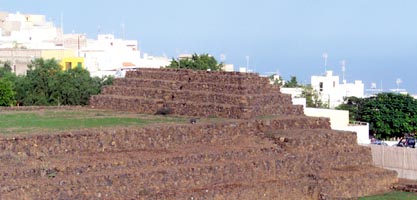 Folly and Bravado's Tenerife Tour
Folly and Bravado's Tenerife Tour Folly and Bravado's Tenerife Tour
Folly and Bravado's Tenerife Tour
Actually, this really is a huge puzzle and Tenerife is really not geared up for visitors wanting cultural information to the level we require. We have to say though, that the unusual nature of our requests has brought the best out of the tourism office who are more accustomed to much more mundane enquiries like where you can get diarrhoea tablets etc. But with the best will in the world and with the museum closed, there's not much they can really do for us.
 |
Despite this, we have been able to get something of a handle of these Canary Islands pyramids and their builders. The inhabitants when the Spanish first invaded in earnest in 1402 were called the Guanches. Somewhat strangely, they were fair skinned and frequently fair-haired Given that we are closest to Africa, on the face of it, this seems a huge anomaly. But analysis of the remnants of their language together with their genetics now heavily indicates that their origins are Berber, from the Atlas mountains in northern Morocco. Although much diluted by many invasions, traces of these extremely ancient people do still survive there. But being mountain dwellers, not traditionally noted seafarers, how did they end up in the Canary Islands? Compounding this dilemma is that no interaction between the various islands is thought to have occurred despite being able to see from one to another. They simply didn't sail, canoe or even raft from one to another. And riddle upon riddle, there are rock carvings depicting boats on most of the islands.
Being principally cave dwellers and given that these volcanic islands are laced with hollow tubes in the lava flows, structural building as we know it was never much of a requirement. So why then did they build pyramids? Our initial impressions of Güímar were far from favourable but we do have to accept that our knowledge and experience of pyramids in general, is far greater than most. This site has been tailored to suit curious day-trippers rather than us fanatics and has been restored to meet their needs. In our arguably over critical eyes, a little excessively. Whether they are genuine pyramids or not is actually hard to assess, given the information made readily available but delve a little deeper and on the balance of probability, we suspect that they are.
We've revisited and having checked our astronomical software, now accept the validity of the solstitial alignments, relative to local topography. What exists there now are undeniably pyramids although how accurately they reflect the original structures is open to conjecture. What strengthens this particular site's case however, is another possible pyramid, Los Cancajos on La Palma island. Early Spanish records also indicate other similar structures existed, quite possibly pyramids but sadly, now destroyed and transformed into banana plantations.
But the Berbers, despite their proximity to Egypt, are not know pyramid builders so why then, did they build them here? Well, we think we might have a viable explanation. The Phoenicians, a mysterious sea faring nation based in the Mediterranean, are known to have extended their trade routes past Gibraltar and down the African coast of Morocco. We suspect they may have enslaved Berbers and transported them here as labourers, possibly to mine volcanic obsidian, a valuable commodity in those times. When the Phoenician culture collapsed or maybe when the obsidian was exhausted, these primitive people were simply left stranded here. Disconnected from their own culture for generations, they may well have adopted the ritualistic practices of their masters and continued doing so.
As is usual with our trips we have many more questions that remain to be answered. But we have at least made contact and now feel comfortable that Tenerife is a suitable site for the first Earth Pyramid Network installation.